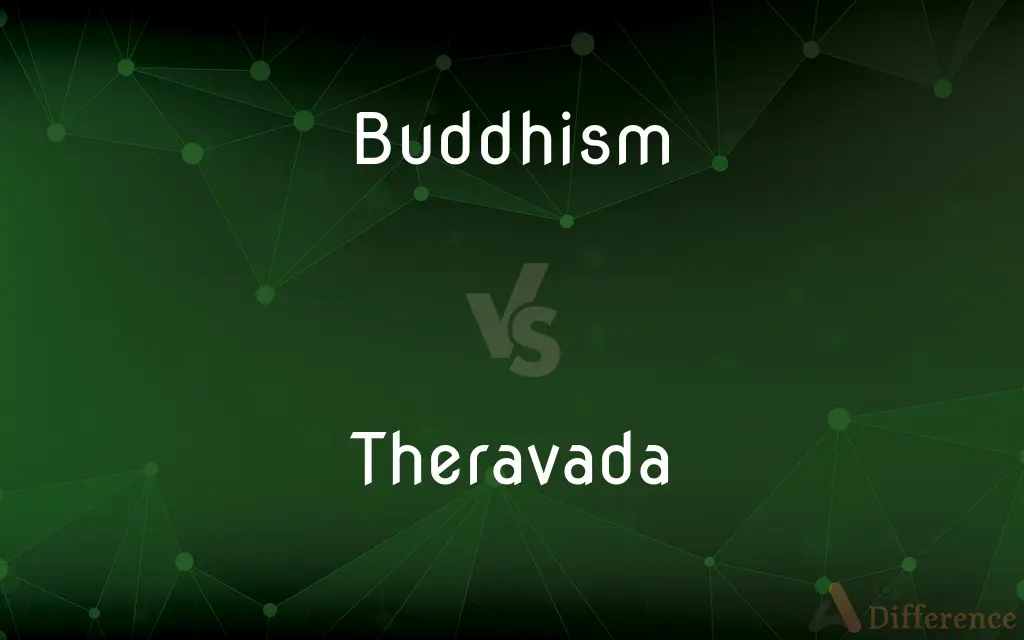Buddhism vs. Theravada — What's the Difference?
By Maham Liaqat & Fiza Rafique — Published on March 8, 2024
Buddhism is a broad religion encompassing various traditions, beliefs, and practices based on the teachings of Siddhartha Gautama, while Theravada is a major branch of Buddhism focusing on the earliest teachings and practices.

Difference Between Buddhism and Theravada
Table of Contents
ADVERTISEMENT
Key Differences
Buddhism, as a whole, includes a wide range of philosophical teachings, cultural practices, and spiritual paths aimed at ending suffering and achieving enlightenment. It diverges into several schools, including Theravada, Mahayana, and Vajrayana, each with its interpretations and practices. Theravada, known as the "Teaching of the Elders," prioritizes the Pali Canon as its scriptural foundation and emphasizes individual enlightenment through meditation and adherence to monastic rules.
Theravada Buddhism is prevalent in countries like Sri Lanka, Thailand, and Myanmar, and it stresses the importance of the monastic community in preserving and transmitting the Buddha's teachings. Other branches of Buddhism, particularly Mahayana, have developed additional texts and practices, focusing on the bodhisattva path, which emphasizes compassion and enlightenment for all beings.
The practice of meditation is central to both Theravada and the broader Buddhist tradition, but Theravada specifically emphasizes vipassana (insight) and samatha (tranquility) meditation techniques as paths to enlightenment. Mahayana and Vajrayana also incorporate a wide range of meditation practices, including Zen meditation and tantric practices, with varying goals and emphases.
Theravada holds to the ideal of the arhat, a person who has achieved personal enlightenment and liberation from the cycle of birth and death. In contrast, Mahayana Buddhism introduces the concept of the bodhisattva, a being who seeks enlightenment both for themselves and for the benefit of all sentient beings, delaying their own final enlightenment to assist others.
The teachings and practices of Buddhism, regardless of the school, all trace back to the foundational teachings of the Buddha, including the Four Noble Truths and the Eightfold Path. Theravada is often regarded as closer to these original teachings, with a focus on simplicity, meditation, and adherence to monastic rules as a way of life.
ADVERTISEMENT
Comparison Chart
Scope
Encompasses various schools and traditions
A major school focusing on early teachings
Scriptures
Includes texts recognized by specific schools (e.g., Pali Canon, Mahayana Sutras)
Primarily relies on the Pali Canon
Geographical Spread
Asia and worldwide
Southeast Asia (Sri Lanka, Thailand, Myanmar)
Focus
Varies by school (enlightenment, compassion)
Individual enlightenment, monastic life
Key Practices
Meditation, mindfulness, ethical living
Vipassana and Samatha meditation, monastic discipline
Ideal
Varies (Arhat, Bodhisattva, Buddha)
Arhat (one who has achieved enlightenment)
Philosophical Emphasis
Dependent on school (emptiness, compassion)
Insight into the nature of reality, ethical conduct
Compare with Definitions
Buddhism
Teaches the Four Noble Truths.
The Four Noble Truths are central to Buddhist teaching.
Theravada
Emphasizes individual enlightenment.
Theravada Buddhism focuses on the individual's path to enlightenment.
Buddhism
A religion based on ending suffering.
Buddhism teaches the path to end suffering through enlightenment.
Theravada
Teaching of the Elders.
Theravada is known as the 'Teaching of the Elders' for its adherence to early texts.
Buddhism
Focuses on meditation and mindfulness.
Buddhism emphasizes meditation as a means to attain insight.
Theravada
Ideal of the arhat.
The ultimate goal in Theravada is to become an arhat, a fully enlightened individual.
Buddhism
Advocates for ethical living.
Buddhism calls for ethical living as part of the Eightfold Path.
Theravada
Relies on the Pali Canon.
The Pali Canon is the authoritative scripture of Theravada Buddhism.
Buddhism
Encompasses multiple traditions.
Buddhism includes Theravada, Mahayana, and Vajrayana traditions.
Theravada
Practices vipassana meditation.
Vipassana meditation is a key practice in Theravada for developing insight.
Buddhism
The religion represented by the many groups, especially numerous in Asia, that profess varying forms of this doctrine and that venerate Siddhartha Gautama.
Theravada
A conservative branch of Buddhism that adheres to Pali scriptures and the nontheistic ideal of self-purification to nirvana and is dominant in Sri Lanka, Burma, Thailand, Laos, and Cambodia.
Buddhism
The teaching of Siddhartha Gautama that life is permeated with suffering caused by desire, that suffering ceases when desire ceases, and that enlightenment obtained through right conduct, wisdom, and meditation releases one from desire, suffering, and rebirth.
Common Curiosities
Can laypeople practice Theravada Buddhism?
Yes, laypeople can practice Theravada Buddhism, focusing on ethical conduct, meditation, and supporting the monastic community.
What is the main difference between Buddhism and Theravada?
Buddhism refers to the entire religion that includes various schools and practices, while Theravada is a specific tradition within Buddhism that emphasizes early teachings and monastic discipline.
How does Theravada Buddhism differ from Mahayana Buddhism?
Theravada focuses on the individual's path to enlightenment and adherence to the original teachings, while Mahayana introduces the bodhisattva ideal, emphasizing compassion and enlightenment for all beings.
Is Theravada Buddhism more conservative than other forms?
Yes, Theravada is often considered more conservative, emphasizing strict adherence to the Buddha's original teachings and monastic discipline.
What are the key texts of Theravada Buddhism?
The key texts are the Pali Canon, which includes the Sutta Pitaka, Vinaya Pitaka, and Abhidhamma Pitaka.
How do Theravada practices differ in various countries?
While the core teachings and practices are consistent, cultural variations exist in how Theravada is practiced in different countries, reflecting local traditions and interpretations.
How do Theravada Buddhists view the Buddha?
Theravada Buddhists view the Buddha as the supreme teacher who attained full enlightenment and shared his insights to help others achieve the same.
What is the goal of Theravada meditation?
The goal is to achieve insight into the true nature of reality, leading to enlightenment and liberation from the cycle of birth and death.
What is the significance of the monastic community in Theravada?
The monastic community is vital for preserving the teachings, providing guidance to lay followers, and serving as a living example of the Buddha's path.
Do Theravada Buddhists believe in gods?
While Theravada Buddhism acknowledges the existence of gods, it teaches that these beings are also bound by the cycle of samsara and not central to the path of enlightenment.
Share Your Discovery

Previous Comparison
Flood Light vs. Spotlight
Next Comparison
Orthodox Christians vs. Protestant ChristiansAuthor Spotlight
Written by
Maham LiaqatCo-written by
Fiza RafiqueFiza Rafique is a skilled content writer at AskDifference.com, where she meticulously refines and enhances written pieces. Drawing from her vast editorial expertise, Fiza ensures clarity, accuracy, and precision in every article. Passionate about language, she continually seeks to elevate the quality of content for readers worldwide.
















































